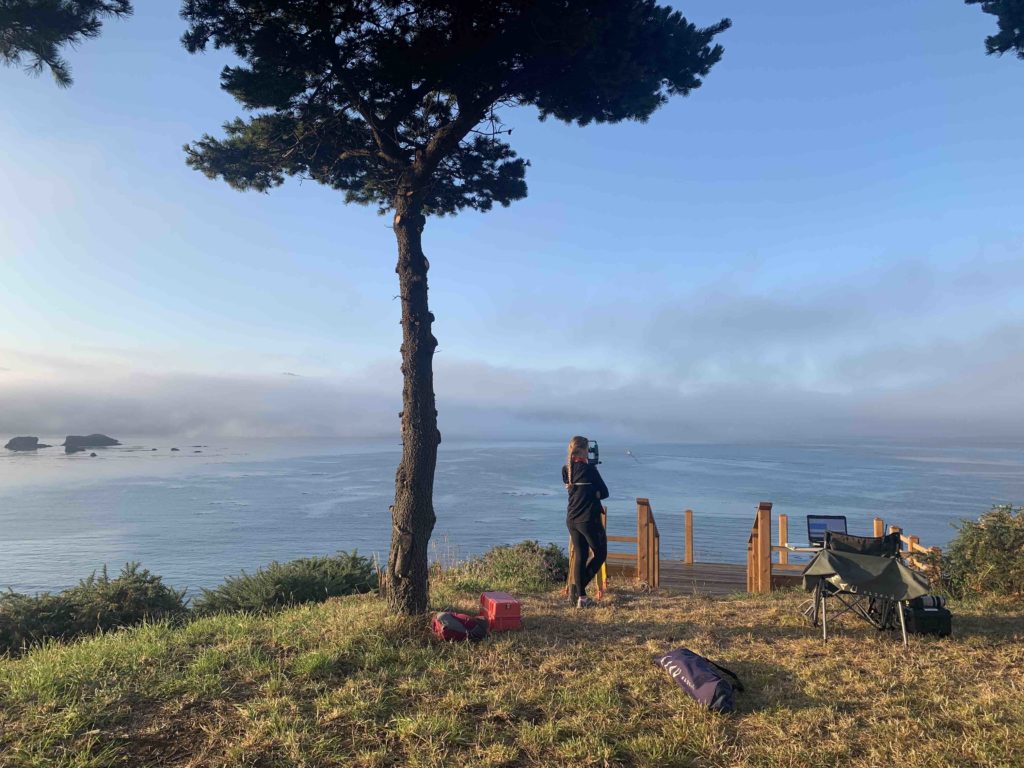By Noah Dolinajec, MSc student, Vrije Universiteit Brussel, GEMM Lab summer intern
There is something special about the Oregon Coast. It’s like nowhere else in the world. When Lisa told me that gray whales are understudied on our coastline, I secretly and selfishly thought to myself, “I hope it stays that way”. Then I would have a chance to be a pioneer one day too, studying something along this rugged coast full of life, death and everything in between, that no one has answered before. Of course, I only feel this way half of the time.
Yet, the more time I spend in Port Orford, the more I realize that our coastline truly is one of those last frontiers. A place where fundamental questions have yet to be explored, where the passing of seasons brings with it a violent change in conditions. From sunny summer days on the Port Orford beaches taking in the soft glistening of sunlight illuminating Redfish Rocks Marine Reserve, to cold, dark and stormy months with no end in sight and nothing but the sound of wind curving around the bends of your home and rain puttering against the windows.

But no matter the season, no matter the conditions, the Oregon Coast harnesses something truly special, truly extraordinary. A cyclical diversity of life.
Since I was a kid, the Oregon Coast has inspired me. Not always to think about wildlife, in fact, mostly in other ways. To contemplate more primal philosophical questions. At 28 years old, it’s been a longer road than expected to get to this point, working with these amazing people, in this amazing place, on this amazing project. And the more time that passes, the more failures, missteps and dysfunctional experiences I absorb, the more that I learn about what really needs to change. In the world of course, but, mostly in science.
In the past few years, as I eek closer to 30, and I begin to look back on some of the adventures I have taken in my life, I take heavy note of where I am now, sitting on a kayak in Mill Rocks sampling for gray whale prey abundance and distribution, or atop the cliff, gazing out into the open ocean waiting patiently and graciously (at least trying to be) for a small poof of water spray from the beating surface of the sea. That little poof? It may not seem like much but it’s a sign of life. Of an age-old journey, one we know very little about. And here I am, a part of it, albeit a small one, but nevertheless, forever a part of that great journey.
And without losing sight of my job, sampling for zooplankton or tracking the whales as they move across the open water, I’ve found myself thinking about the depth of being involved in such an ancient process, and considering a very important question. One that doesn’t spend nearly enough time in the day-to-day conversation of an academic…
What exactly is a scientist? And how does one become a scientist?
The academic path to the sciences is exclusionary, beyond any reasonable level. It discriminates on gender, race, experience and age. Making the sciences, which are meant as a tool to better the world and make useful contributions to society and the future, feel inaccessible for so many people full of potential but without the right boxes ticked on a form.
How many beautiful ideas have been left to decay because of the ego that science has built for itself?

Don’t get me wrong, I love science, it has given me joy that other things in life cannot. It has shown me both the complexity of the world and the simplicity of how we view it. And I believe that science can still be the future. But in order for science to command our future, to guide us in the right direction, it cannot be a hierarchy of antiquated procedures any longer. We must open our arms, our minds and our resources to take chances on students, far and wide, that may lack traditional training but instead have other skills or experiences to offer science. Science needs an overhaul. Science needs diversity.
After all, change of perspective can be a profound driver of scientific results, can it not?
Here in Port Orford, in this bizarre year of 2020, we have the beginning, the makings if-you-will, of that very diversity that I am speaking of. The four of us, ‘The Theyodelers’ as we righteously call ourselves, each come from such drastically different places in life only to meet under the same roof for 6 weeks and miraculously not only survive together, but thrive together.

And that, that essence of positivity that we have been able to build around one another this season, is exactly what I mean when I say that science needs an overhaul.
We do not all find our way to this moment, doing science in such an inspiring place, in the same way. Some of us are born with the innate ability to see the world through objective eyes, the kind of mind that makes great science happen from an early age. And others find our way to science after being enlightened by trials and travails, failures and mistakes, missed opportunities and missteps.
No matter the journey, we all ended up here. Watching these great gray giants on their journeys.
And it all comes full circle doesn’t it?
Each of our journeys, human or whale, can lead to the very same point despite beginning at very different places. And in that diversity of experience, of life, of age, of color, is where we find our brightest moments, our grandest ideas and our future, driven by science.














